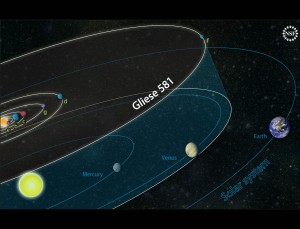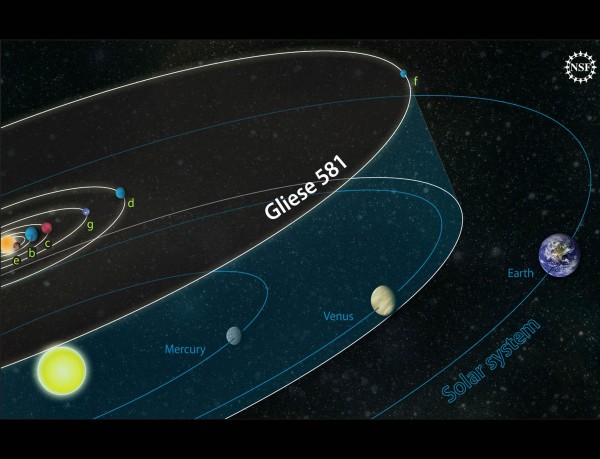
In a nutshell:
- At last count, astrophysicists discovered 493 exoplanets
- Many of them are even larger than Jupiter which makes them too hot and inhospitable
- Why do we need another earth? Since the Earth may not be habitable for ever
- The Earth’s oceans will evapourate in the next billion years (unless we build a solar shield or something to that effect)
- Gliese 581 was found orbiting within the habitable zone hence it’s an exciting discovery if proved
- How much will this cost? Researchers peg the cost at around $7 bn
- This is less than half of NASA’s entire annual budget, and less than half on the amount ($15 bn) spent by Americans on bottled water in 2007
On 29th September, a team of planet hunters from the University of California (UC) Santa Cruz, and the Carnegie Institution of Washington announced the discovery of a planet with three times the mass of Earth orbiting a nearby star at a distance that places it squarely in the middle of the star’s “habitable zone”.
To astronomers, a “potentially habitable” planet is one that could sustain life, not necessarily one where humans would thrive. Habitability depends on many factors, but having liquid water and an atmosphere are among the most important.
The research, sponsored by NASA and the National Science Foundation, placed the planet in an area where liquid water could exist on the planet’s surface. If confirmed, this would be the most Earth-like exoplanet yet discovered and the first strong case for a potentially habitable one.
The new findings are based on 11 years of observations of the nearby red dwarf star Gliese 581using the HIRES spectrometer on the Keck I Telescope. The spectrometer allows precise measurements of a star’s radial velocity (its motion along the line of sight from Earth), which can reveal the presence of planets. The gravitational tug of an orbiting planet causes periodic changes in the radial velocity of the host star. Multiple planets induce complex wobbles in the star’s motion, and astronomers use sophisticated analyses to detect planets and determine their orbits and masses.
This discovery, according to a NASA release, was the result of more than a decade of observations using the W. M. Keck Observatory in Hawaii — one of the world’s largest optical telescopes. “Keck’s long-term observations of the wobble of nearby stars enabled the detection of this multi-planetary system,” said Mario R. Perez, Keck program scientist at NASA Headquarters in Washington. “Keck is once again proving itself an amazing tool for scientific research.”
Steven Vogt, professor of astronomy and astrophysics at UC Santa Cruz, and Paul Butler of the Carnegie Institution lead the Lick-Carnegie Exoplanet Survey. The discovery of two new planets around Gliese 581 brings the total number of known planets around this star to six, the most yet discovered in a planetary system outside of our own. Like our solar system, the planets around Gliese 581 have nearly-circular orbits.
The new planet designated Gliese 581g has a mass three to four times that of Earth and orbits its star in just under 37 days. Its mass indicates that it is probably a rocky planet with a definite surface and enough gravity to hold on to an atmosphere.
But Gliese 581 is many light years away. A light year is a way of measuring distance. A light nanosecond — the distance light can travel in a billionth of a second — is about 1 foot (about 30 cm) and most of us are comfortable with units like these and with miles and kilometers because we use them daily.
With the universe, however, things are different. The distances are gigantic. For example, the closest star to Earth (besides our sun) is something like 24,000,000,000,000 miles (38,000,000,000,000 kilometers) away. That’s the closest star.
So to measure really long distances, people use a unit called a light year. Light travels at 186,000 miles per second (300,000 kilometers per second). Therefore, a light second is 186,000 miles (300,000 kilometers). A light year is the distance that light can travel in a year, or: 186,000 miles/second * 60 seconds/minute * 60 minutes/hour * 24 hours/day * 365 days/year = 5,865,696,000,000 miles/year. A light year is 5,865,696,000,000 miles (9,460,800,000,000 kilometers). For example, it takes just around 8 minutes, 20 seconds for the sun’s light to reach the earth.
But the newly-announced planet, Gliese 581, is located 20 light years away (around 120 trillion miles) from Earth in the constellation Libra, and has two previously detected planets that lie at the edges of the habitable zone — one on the hot side (planet c) and one on the cold side (planet d). While some astronomers still think planet d may be habitable if it has a thick atmosphere with a strong greenhouse effect to warm it up, others are skeptical. The newly-discovered planet g, however, lies right in the middle of the habitable zone.
Can humans travel the distance? Current space shuttles don’t go much faster than 17,500 miles per hour. At that pace, it would take 766,000 years to get to Gliese 581 g—that’s more than three times longer than homo sapiens have been around. Besides, human beings could be torn apart by the high gravity forces and unmanned vehicles could face interstellar dust and particles.
The laws of physics will need revisiting — wormhole, warps, teleportation (wondering what kind of atoms would be reassembled at the other end), laser sails??? Perhaps, NASA (with its Breakthrough Propulsion Physics (BPP) research group) may come up with an answer on interstellar travel in our lifetime.
Footnote: NASA to study Mars atmosphere
On September 15, NASA announced that it plans a mission to Mars in 2013. The $485 million project named the Mars Atmosphere and Volatile Evolution Mission (MAVEN), will investigate how the red planet lost most of its atmosphere. This will be critical in understanding whether there has been life on Mars or not.
Mars once may have had a thicker atmosphere which was lost due to exposure to solar radiation that quickly makes water evapourate from the surface. Such harsh conditions are the end of the road for known forms of life, but it is possible that the martian life went underground, where liquid water may still exist and radiation can’t reach.
There are other theories as well. Mars has over 20 ancient craters larger than 600 miles across, scars from giant impacts by asteroids, of the size of small moons. This bombardment could have blasted large amounts of the martian atmosphere into space. Mars is the fourth planet from the Sun in the Solar System. It is often described as the “Red Planet” as the iron oxide prevalent on its surface gives it a reddish appearance.
MAVEN is scheduled for launch between November 18 and Dec. 7, 2013. If it is launched on November 18, it will reach Mars on Sept. 16, 2014 for a year-long mission.
